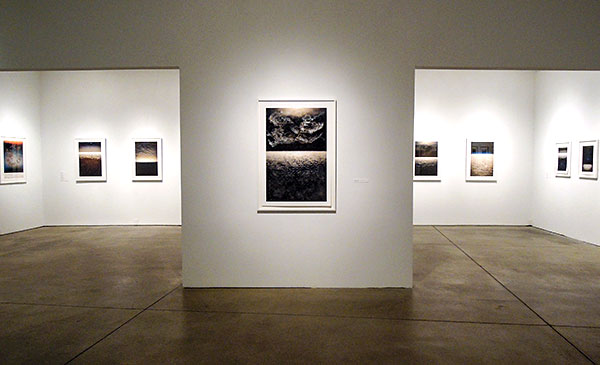Idiopathic Aura: Artist’s Introduction
 |
| Idiopathic Aura January 24, 2014–March 17, 2014, Visual Arts Center, Richmond, Virginia |
In my early teens I temporarily lost my eyesight due to a rare illness called Idiopathic Pseudotumor Cerebri. Once a week, for the next four years, I spent hours alone in a small, dark room peering into a massive machine that mapped my visual fields. For four hours, I stared at a single black dot, pushing a button each time it was joined by a flash of white or gray or blue light, and then waited for the doctors to return with a verdict—whether I was to return to high school or a hospital bed. It was a terrifying and mystical experience, redefined weekly by the reading of my visual field test results. My current body of work is an investigation onto the psychological and physical impact of this experience.
I found the source material for this project eleven years ago in a university’s library dumpster, a catalog listing three years of the school’s collection of periodicals available to the blind community. The only printed text on the catalog served as identification for individuals who read with their eyes instead of their fingers. Each page, slightly stained, revealed the most popular sections with the trace oils of touch. Through its use, the catalog evolved into a visually enthralling collaboration between digitized text and the human hand.
Roll over the image below to magnify detail
Mediation Medium, 2013
Archival pigment print on velvet paper, infused with cold wax and metallic powders
18 x 12 in.
I employed a similar collaboration between my hand and the mechanical eye of the camera while making this work. Each page of the Braille catalog was photographed under countless combinations of light and material positioning and printed onto velvet paper. The entire surface of each piece was then hand coated with cold wax. Massaging the oily medium into the print obscures the visual clarity of the sourced Braille and engages my hand in an intimate reading of the surface information. I then painted over the waxed photograph with dry pigments and metallic powders, which animate and refract environmental light. The process was finalized by applying high levels of heat to the print with a hand torch or embossing gun, infusing the wax and powders into the image.
Tom Condon: Idiopathic Aura, 2013
Video by Harrison Möenich
Each finished piece looks as though it has been frozen between a workable and fixed state. Although 18 years have passed since my last visual field test I am haunted by the possibility of returning to that experience, and feel stuck between states. Historically, the distance of the visible horizon represented the maximum range of communication. Pilots are taught to maintain their spatial orientation by referring to the horizon. I stress an implied horizon in this work to communicate my own need to establish a solid ground. While creating this body of work I have learned to embrace my own spatial disorientation and discovered atmospheric wonders through the intimacy of looking into the subtle blankness of discarded Braille paper. ![]()
Videographer Harrison Möenich lives and works in Richmond, Virginia. A graduate of the VCU School of the Arts, Möenich received a BFA in both photography and filmmaking. He has produced several short documentary videos for the Visual Arts Center of Richmond and VCU, and his work is part of Capital One’s permanent collection.
Idiopathic Aura: Artist’s Introduction ![]()
Caroline Wright: On Condon’s Idiopathic Aura
Idiopathic Aura